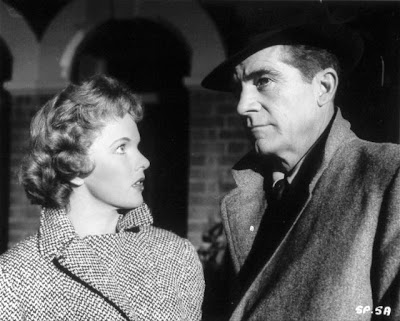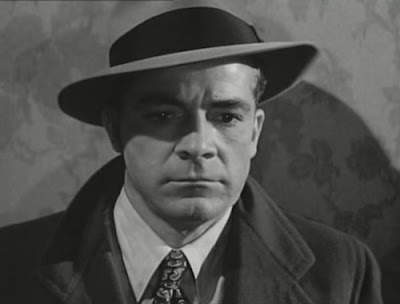
“A doll in Washington Heights once got a fox fur outta me.” -Dana Andrews as tough detective Mark MacPherson in the classic film noir "Laura" (1944) directed by Otto Preminger.

Dana Andrews (1909-1992) worked with distinguished directors such as John Ford, Lewis Milestone, Otto Preminger, Fritz Lang, William Wyler, William A. Wellman, Mervyn Le Roy, Jean Renoir, and Elia Kazan. He played romantic leads alongside the great beauties of the modern screen, including Joan Crawford, Elizabeth Taylor, Greer Garson, Merle Oberon, Linda Darnell, Susan Hayward, Maureen O'Hara, and most important of all, Gene Tierney, with whom he did five films.

Retrospectives of his work often elicit high praise for an underrated actor, a master of the minimalist style. His image personified the "male mask" of the 1940s in classic films such as Laura, Fallen Angel, and Where the Sidewalk Ends, in which he played the "masculine ideal of steely impassivity." No comprehensive discussion of film noir can neglect his performances. He was an "actor's actor."

Here at last is the complete story of a great actor, his difficult struggle to overcome alcoholism while enjoying the accolades of his contemporaries, a successful term as president of the Screen Actors Guild, and the love of family and friends that never deserted him. Based on diaries, letters, home movies, and other documents, this biography explores the mystery of a poor boy from Texas who made his Hollywood dream come true even as he sought a life apart from the limelight and the backbiting of contemporaries jockeying for prizes and prestige.

Teresa Wright and Dana Andrews in "The Best Years of Our Lives" (1946) directed by William Wyler
When you watch Dana Andrews in his best, most complex performances, you wonder what he is thinking. The cerebral quality of his greatest work is striking. He is holding back something, and that quality is the enigma. Some part of him --at least in some performances-- seems not to want to emote. He became a star after Laura, but he never became quite the star that Bogart or Cooper or Gable were. They were Hollywood. Dana Andrews was only in Hollywood.

Discovered in 1938 by one of Sam Goldwyn's scouts, Dana slowly made his way up the ranks of supporting roles to stardom with Laura in 1944. The decade of his greatness, with roles in The Ox-bow Incident (1943) and The Best Years of Our Lives (1946), still did not making acting entirely suitable to his temperament. He studiously avoided affairs with leading ladies--most notably Joan Crawford--and cultivated a homebody image. Devoted to his wife and four children, he went to Hollywood parties only when "the job" seemed to call for it. His closest friends tended to be character actors and directors.

Dana Andrews wanted to be a great actor, and to get the best roles he also needed to be a star. Sure, he enjoyed the limelight, but he did not grouse when the plum roles began to elude him in the early 1950s, and he had to settle for lesser parts. That Hollywood--for all it gave him--was not his final aim became clear when he quit drinking for good in 1970 and returned to the stage in dinner theater. He often co-starred with his wife, Mary Todd, a consummate comedienne who decided marriage to Dana Andrews and a family were more important than her career. Unlike a lot of husbands in his business, though, Dana never forgot what his wife sacrificed for him, and it gave him profound pleasure to reunite with her on the stage, where he first met her in a production at the Pasadena Playhouse.

How this wonderful human being made his way through the phoniness and glitz of Hollywood is quite a story. He was hard to grasp. Few of his fellow professionals ever got to know him. Read Gene Tierney's autobiography, and you will see what I mean. She starred with Dana in five pictures, and yet she has very little to say about the man who always showed up for work on time, always knew his lines, and was never less than a gentleman. To Sam Goldwyn, Darryl Zanuck, and other producers Dana was an enigma. To many of his fellow actors, he was a hero. In the end, though, I thought my reader's title better than my own. He suggested: "Hollywood Enigma: Dana Andrews".

Called "one of nature's noblemen" by his fellow actor Norman Lloyd, Dana Andrews emerges from Hollywood Enigma as an admirable American success story, fighting his inner demons and ultimately winning. In his small boat named "Katherine", Dana Andrews raced Bogart's boat "Santana" [a fifty-five-foot sailing yacht, which Bogie had bought from Dick Powell and June Allyson] near Catalina, the only place [where] Dana really fraternized with stars like John Wayne, Maureen O'Hara, and Dick Powell. -"Hollywood Enigma: Dana Andrews" by Carl Rollyson (which will be released on September 1, 2012)

Peggy Cummins and Dana Andrews in "Night Of The Demon" (1957) directed by Jacques Tourneur

"Night Of The Demon" was adapted from M.R. James's supernatural story "Casting the Runes" (1911). One of Hitchcock's screenwriters Charles Bennett owned the rights to "Casting the Runes" and adapted it into a script entitled "The Haunted", which initially sparked some interest with the likes of Robert Taylor and Dick Powell before independent producer Hal E. Chester sealed the deal for the film rights. -"Dana Andrews: The Face of Noir" by James McKay (2010)

Linda Darnell and Dana Andrews in a promotional still of "Fallen Angel" (1945) directed by Otto Preminger

Dick Powell and Linda Darnell in "It Happened Tomorrow" (1944) directed by René Clair
STUDIO EXPRESSIONISM (1944-1947):
The early developments of film noir paved the way of the trio of films released in 1944: "Double Indemnity", "Laura" and "Murder, My Sweet" whose success was crucial to the establishment of the cycle.

Dick Powell as Philip Marlowe in "Murder, My Sweet" (1944) directed by Edward Dmytryk
"Beneath Marlowe's tough exterior, [Dick] Powell neatly implies in his superbly underplayed performance, [there] is a humanity that can be reached."

"Claire Trevor, as the bewitching platinum blonde temptress who is deadlier than any male, played the dangerous noir siren Helen Grayle to perfection." -Creatures of Darkness: Raymond Chandler, Detective Fiction, and Film Noir" (2000) by Gene D. Phillips

Dick Powell and Evelyn Keyes in "Johnny O'Clock" (1947) directed by Robert Rossen

"This is a smart whodunit, with attention to scripting, casting and camerawork lifting it above the average. Pic has action and suspense, and certain quick touches of humor to add flavor. Ace performances by Dick Powell, as a gambling house overseer, and Lee J. Cobb, as a police inspector, also up the rating.

Plot concerns Powell's operation as a junior partner in Thomas Gomez's gambling joint, and his allure for the ladies, especially Ellen Drew, the boss's wife. A cop tries to cut into the gambling racket and is murdered. The hatcheck girl, sweet on the cop, is also killed. When the checker's dancer sister (Evelyn Keyes) comes to find out what happened to the girl, she steps into a round of mystery centering about Powell.

Although the plot follows a familiar pattern, the characterizations are fresh and the performances good enough to overbalance. Dialog is terse and topical, avoiding the sentimental, phoney touch. Unusual camera angles come along now and then to heighten interest and momentarily arrest the eye. Strong teamplay by Robert Rossen, doubling as director-scripter, and Milton Holmes, original writer and associate producer, also aids in making this a smooth production."
Source: www.variety.com
"Rossen deftly handles the complex plot of Johnny O'Clock, from a story by Milton Holmes. Pete Marchettis (Thomas Gomez) is the senior partner and owner of a New York gambling house. The junior partner and overseer of the casino is the self-assured Johnny O'Clock (Dick Powell). A local cop on the take, Chuck Blayden (Jim Bannon), cozies up to Pete and tries to convince him that he would be better at Johnny's job.

Chuck's girlfriend Harriet (Nina Foch) is found dead in her gas-filled apartment and Police Inspector Koch (Lee J. Cobb) investigates. Harriet was murdered, and Koch and Harriet's sister Nancy (Evelyn Keyes) know it. Johnny O'Clock agrees to help Nancy prove that Harriet was murdered, but he must be careful to conceal his past relationship with Pete's wife Nellie (Ellen Drew). Inspector Koch suspects that Johnny and Pete are involved in the murder, and proceeds to make life difficult for both of them, especially after Chuck is found dead in the river.

Johnny O'Clock features many strong elements of Film Noir, such as the brooding black-and-white photography by Burnett Guffey. (Guffey went on to photograph Rossen's All the King's Men [1949], as well as such important 1950s Noir dramas as Nicholas Ray's In a Lonely Place [1950], Dmytryk's The Sniper [1952], and Fritz Lang's Human Desire [1954]).

Certainly Johnny O'Clock also features the sort of seedy urban settings and labyrinthine plotting that Post-War Noir favored, but critic Carl Macek argues (in Film Noir: An Encyclopedic Reference to the American Style) that the movie does not quite qualify for the term: "...the film is emotionally detached and the character portrayed by Powell was not obviously vulnerable. It is through a sense of the protagonist's weaknesses that most films of this nature approach the noir classification. But Johnny O'Clock is not privy to this important attitude, although the motivations are correct and the settings are particularly corrupt and ambiguous. The elements lacking are a sense of fear and powerlessness."
Source: www.tcm.com
 Humphrey Bogart
Humphrey Bogart Sterling Hayden
Sterling Hayden Dana Andrews
Dana Andrews Dick Powell
Dick Powell Burt Lancaster
Burt Lancaster Alan Ladd
Alan Ladd

























































